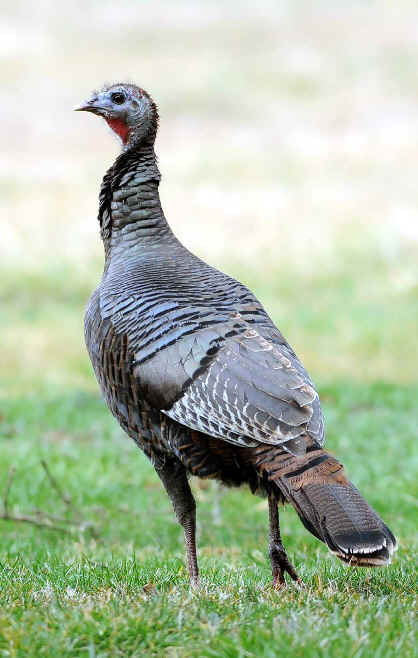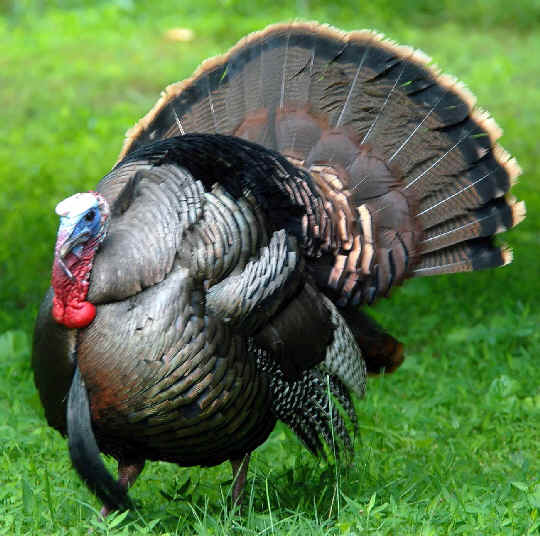 |
PO Box
9021, Wilmington, DE 19809, USA E-mail: font@focusonnature.com Phone: Toll-free in USA 1-888-721-3555 or 302/529-1876 |
 |
PO Box
9021, Wilmington, DE 19809, USA E-mail: font@focusonnature.com Phone: Toll-free in USA 1-888-721-3555 or 302/529-1876 |
About
the Turkey (A Feature at Thanksgiving)
Armas Hill has presented the "Birdline", originally from
Philadelphia, on the phone and internet for over 3 decades, and on the radio
in Delaware for about 10 years.
Links:
A
List & Photo Gallery of North American Birds, in 6 Parts

A female Wild Turkey
(photo by Howard Eskin)
The Birdline on the Radio, as it was on November 26, 1999:
As Thanksgiving
has been a uniquely American holiday, the TURKEY is a uniquely American
bird.
We all know that TURKEYS, like CHICKENS, occur in barnyards. And, they're
grown for human consumption. Throughout the world, CHICKENS, some DUCKS and
TURKEYS have become domesticated.
CHICKENS and some of the DUCKS were originally wild in Asia.
The TURKEY, and the MUSCOVY DUCK, however, have existed in the wild, and
continue to, only in the Americas.
TURKEYS were domesticated in the Americas, in Mexico, by
the Aztecs, long before the arrival of the Europeans. So, that's where the
Spanish first found the TURKEY, and brought it back to Europe in the
16th Century.
Word of a good tasty thing spreads quickly, and so, by 1540, the "TURKIE-FOWL" was
on many European tables, not just in Spain, but even in
England - after it had been served to King Henry the
Eighth.
For a few years after Henry the Eighth ate the first TURKEY in England, the
dish was reserved only for the King. But, in time, many were raised for
consumption, throughout England, and it was birds from that stock, that the
Pilgrims brought with them on the Mayflower for their meals in Massachusetts.
Even though, WILD TURKEYS were abundant around them, in the
forests near Plymouth Rock.
Why would a bird, from America, be called by the Europeans, the
"TURKEY"?
Simply put, confusion - with another bird, also good to eat, from Africa,
known as the GUINEA-FOWL.
Remember, the TURKEY was brought into Europe (from Mexico, by the Spaniards)
into the western Mediterranean.
Northern Europeans, by mistake, thought it came from the Mediterranean
region of the TURKS, brought there from Africa.
Confusion, then, has continued, til now, in the naming (both the common and
scientific).
All of the birds of the world have scientific names, often from the Latin or
Greek language.
That of the TURKEY, MELEAGRIS GALLOPAVO, is a misleading mixture, referring
to GUINEA-FOWL, ROOSTER, and PEACOCK. The TURKEY is not any of these.
Benjamin Franklin wanted the TURKEY, not the EAGLE, to be the US
National Bird. Imagine, our money and stamps could have had TURKEYS on them.
Instead, the TURKEY has been on our plates, especially at Thanksgiving, for
years.
Truly "WILD' TURKEYS in the American woods were WARY: large
bronze-colored birds in the woods that could be very shy and elusive. Their
flight, through the trees, was quick, and strong.
After clearing the treetops, they could sail. with little effort, for a
mile.
They were hard for hunters to shoot. But they did. The last WILD TURKEY was
shot in Massachusetts, for example, in 1851. Today, WILD
TURKEYS have been re-stocked there, and, of course, elsewhere.
Wild, yes, but not as wary as the
originals.
(end of the recording on the radio)

A male Wild Turkey
(photo by Howard Eskin)